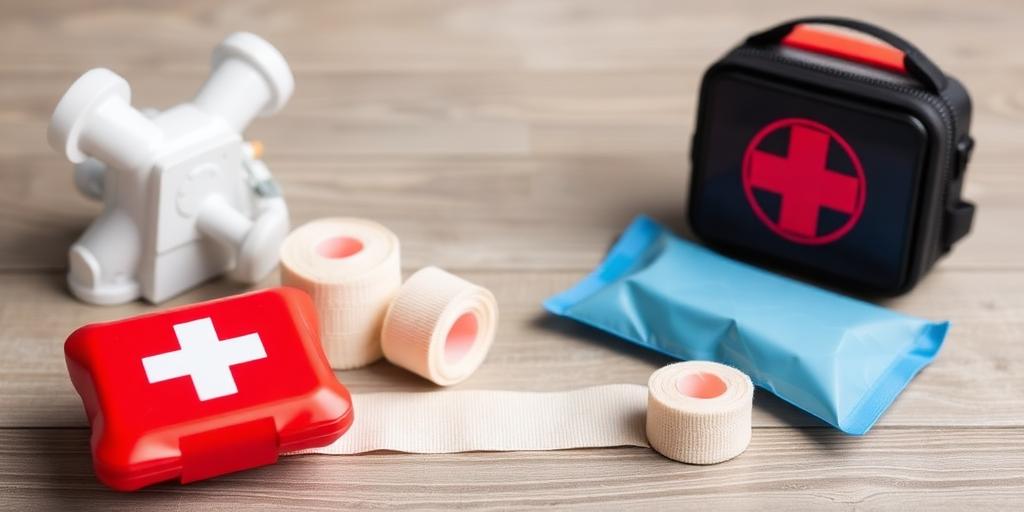First Aid Basics for Common Sports Injuries
Sports injuries are an unfortunate but common part of physical activity. Whether you're a seasoned athlete or a weekend warrior, knowing basic first aid can make a significant difference in recovery and preventing further harm. This guide outlines essential first aid steps for some of the most frequent sports-related injuries.
R.I.C.E. - The Foundation of Immediate Care
The acronym R.I.C.E. stands for Rest, Ice, Compression, and Elevation. It's the cornerstone of initial treatment for many minor to moderate sports injuries.
- Rest: Immediately stop using the injured body part. Continued activity can worsen the injury.
- Ice: Apply ice packs to the injured area for 15-20 minutes at a time, several times a day. Always use a barrier (like a towel) between the ice and skin to prevent frostbite.
- Compression: Use an elastic bandage to wrap the injured area. This helps reduce swelling. Ensure the bandage isn't too tight, which could cut off circulation.
- Elevation: Keep the injured body part raised above heart level whenever possible. This also helps to minimize swelling.
Common Sports Injuries and Their First Aid
1. Sprains
- Definition: A sprain involves the stretching or tearing of ligaments, the tissues connecting bones at a joint. Ankles, knees, and wrists are common locations.
- First Aid: Follow the R.I.C.E. protocol. If weight-bearing is painful or unstable, consider using crutches and seek medical evaluation.
2. Strains
- Definition: A strain is an injury to a muscle or tendon (the tissue connecting muscle to bone). Hamstrings, groin, and calf muscles are frequently affected.
- First Aid: As with sprains, R.I.C.E. is the initial treatment. Gentle stretching may be helpful as pain subsides, but avoid aggressive movements.
3. Bruises (Contusions)
- Definition: Bruises result from impact that damages small blood vessels under the skin.
- First Aid: Apply ice to reduce swelling and pain. Compression can also be beneficial. Bruises usually heal on their own within a week or two.
4. Cuts and Abrasions
- Definition: Cuts (lacerations) and abrasions (scrapes) involve damage to the skin.
- First Aid: Clean the wound thoroughly with soap and water. Apply an antiseptic and cover with a sterile bandage. Seek medical attention for deep or heavily bleeding cuts.
5. Dislocation
- Definition: A dislocation occurs when a bone is displaced from its joint.
- First Aid: Immobilize the joint and seek immediate medical attention. Do not attempt to relocate the joint yourself, as this can cause further damage.
6. Fractures (Broken Bones)
- Definition: A fracture is a break in a bone.
- First Aid: Immobilize the injured area with a splint or sling. Apply ice for pain relief and seek immediate medical attention. Do not attempt to straighten the bone.
When to Seek Professional Medical Attention
While R.I.C.E. can manage many minor sports injuries, it's crucial to know when to seek professional help. Consult a doctor or physical therapist if you experience:
- Severe pain
- Inability to bear weight or move the injured body part
- Obvious deformity
- Numbness or tingling
- Symptoms that don't improve after a few days of R.I.C.E. treatment
Prevention is Key
While knowing first aid is essential, preventing injuries in the first place is even better. Consider these tips:
- Warm-up properly: Prepare your muscles for activity with dynamic stretching.
- Use proper technique: Ensure you're using the correct form for your sport or activity.
- Wear appropriate protective gear: Helmets, pads, and other equipment can prevent serious injuries.
- Stay hydrated: Dehydration can increase your risk of muscle cramps and strains.
- Listen to your body: Don't push through pain. Rest when you need to.
By understanding basic first aid and taking preventative measures, you can minimize the impact of sports injuries and keep yourself or those around you safe and active.









